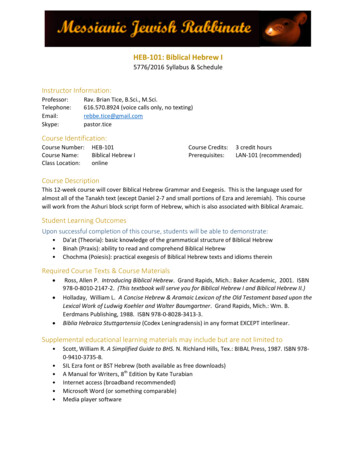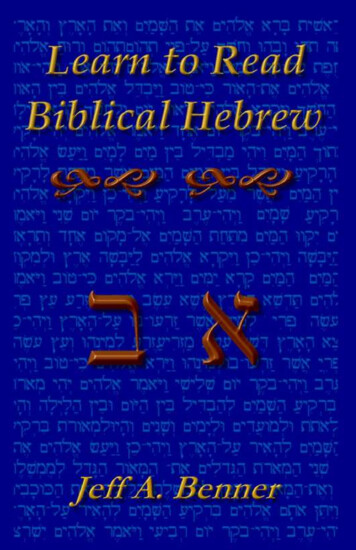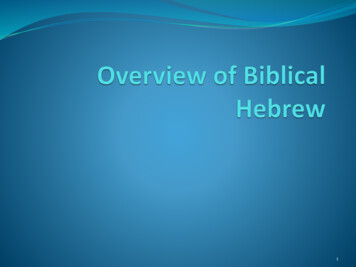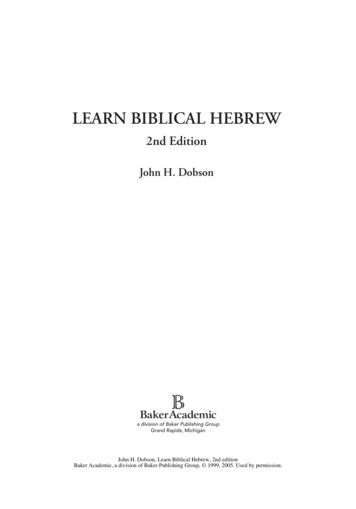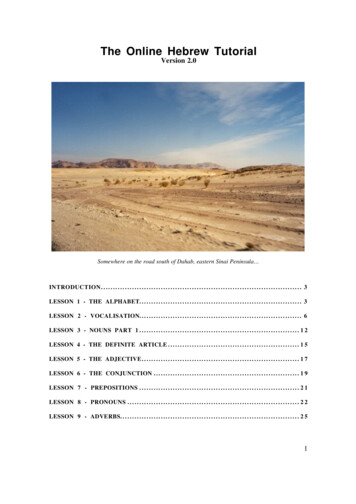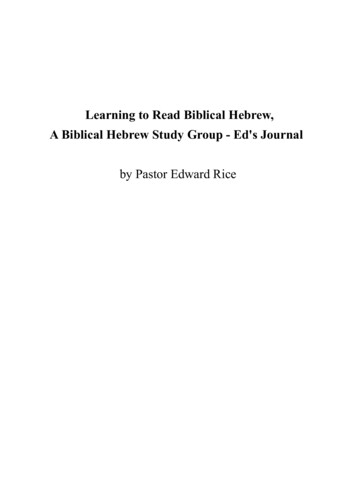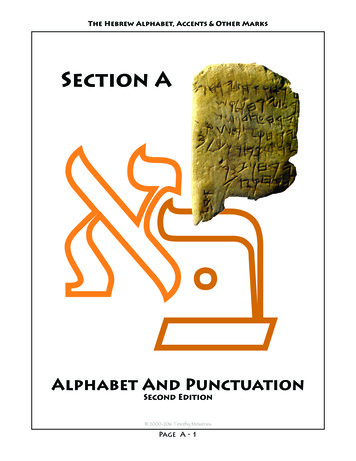
Transcription
BIBLICAL HEBREW IN CHINESE:FOSTERING THE RETHINKING OF TEACHING METHODTHROUGH LANGUAGE DEFAMILIARIZATIONScott N. CallahamBaptist Theological Seminary, SingaporeABSTRACTMost teaching of Biblical Hebrew in universities and seminaries proceedsalong fairly predictable lines, closely approximating the venerableGrammar-Translation tradition of classical language instruction. While afew recent textbooks have departed from this well-travelled path byadvancing more inductive and communicative approaches to languageacquisition, both these newer instructional practices and the familiar olderones assume a specifically Euro-American cultural and linguisticinstructional milieu. The present study examines the teaching of BiblicalHebrew in Chinese through the lens of language defamiliarization, not onlyhighlighting linguistic and cultural factors that differ markedly from thoseof Western teaching traditions, but also drawing out principles of BiblicalHebrew instruction that are applicable to all teaching contexts.LANGUAGE DEFAMILIARIZATION“Why write yet another Hebrew textbook?” so opens “yet another”volume for use in teaching Biblical Hebrew. 1 The introduction of a stillmore recent textbook justifies its publication “despite the deluge of newHebrew textbooks in recent years.” 2 Implicitly assumed in remarkssuch as these is that the current embarrassment of riches in BiblicalHebrew teaching grammars pertains to those written in English. Whileelementary grammars certainly exist in other languages, many aretranslations from English. For example, Weingreen’s A PracticalGrammar for Classical Hebrew has appeared in French, Czech,Korean, Japanese, and Chinese editions. 3 Regarding language of1Arthur Walker-Jones, Hebrew for Biblical Interpretation, Resources for Biblical Study 48(Atlanta: Society of Biblical Literature, 2003), 1.2John A. Cook and Robert D. Holmstedt, Beginning Biblical Hebrew: A Grammar and IllustratedReader (Grand Rapids: Baker Academic, 2013), 9.3Jacob Weingreen, Hébreu biblique: méthode élémentaire, trans. Paul Hebert and Jean Margain(Paris: Beauchesne, 1984); ibid., Učebnice biblické hebrejštiny, trans. Josef Hermach and MladaMikulicová (Prague: Karolinum, 1997); ibid., Hibeurieo munbeop, trans. Ryu Keun-sang (Paju:
HHE 19 (2017)Callaham: Biblical Hebrew in Chineseinstruction, two factors contribute to the relative uniformity of BiblicalHebrew textbooks in the modern era: the preeminence of English incontemporary biblical studies, and the fact that other Indo-Europeaninstruction languages are structurally similar to English.4Indo-European language dominance of the Biblical Hebrew teachingfield suggests that the avenue of language “defamiliarization” holdspromise for fostering the rethinking of basic pedagogical assumptions.5That is to say, the present study proposes that one way to set asideengrained ways of thinking about language teaching is to adopt anentirely fresh vantage point: that of explaining the grammar of BiblicalHebrew through the medium of a non-Indo-European language.On one hand, Modern Hebrew might seem ideally suited to the taskof approaching Biblical Hebrew from a non-Indo-European conceptualbase.6 Students whose native language is Modern Hebrew can receiveBiblical Hebrew instruction in a completely different manner thanspeakers of English, French, or German can, for the living language ofModern Hebrew bears traces of its ancient heritage at all levels, fromvocabulary to grammar to elements of syntax. On the other hand, it isprecisely the “family resemblance” of the two varieties of Hebrew thatdisqualifies Modern Hebrew from effectively catalyzing languagedefamiliarization. In other words, while Modern Hebrew is indeed quitedifferent from Indo-European languages, it is too similar to BiblicalHebrew (the learning objective) to stimulate extensive reevaluation ofKeuriseuchyan, 2000); ibid., Jissen kyūyaku heburugo bunpō, trans. Nabetani Gyoji and MiyazakiShigeru (Tokyo: Inochi no Kotobasha, 1996); ibid., Shiyong Gudian Xibolaiwen Wenfa, trans.Guo Rongmin (Tainan: Tainan Seminary Press, 1998). Weingreen’s grammar is also available ina series of volumes in Braille. Online: http://bartimaeus.us/brl-hot.html (accessed June 15, 2016).4Naudé and Miller-Naudé note the inadequacy of English and Afrikaans teaching grammars for thepurpose of training Bible translators who work in African languages in Jacobus A. Naudé andCynthia L. Miller-Naudé, “A New Biblical Hebrew Teaching Grammar for African BibleTranslators: A Typological Approach,” OTE 24 (2011): 690–707.5“Defamiliarization” casts that which is familiar into a jarringly unconventional frame of reference,thus focusing attention and prompting comprehensive reevaluation of the newly-unfamiliar. SeeR.H. Stacy, Defamiliarization in Language and Literature (Syracuse: Syracuse University Press,1977).6An example of a textbook that moves in the opposite direction, building upon knowledge ofBiblical Hebrew to aid the acquisition of Modern Hebrew reading ability, is Takamitsu Muraoka,Modern Hebrew for Biblical Scholars: An Annotated Chrestomathy with an Outline Grammarand a Glossary, 2nd ed. (Wiesbaden: Harrassowitz, 1998).2
HHE 19 (2017)Callaham: Biblical Hebrew in Chinesehow to teach the subject to speakers of languages other than ModernHebrew itself.7WHY CHINESE?While both Hebrew and Chinese share rootedness in deep antiquity,they stand in separate language families and have not significantlyinfluenced each other through language contact in history. 8Additionally, Hebrew and Chinese both markedly differ from Englishand other Indo-European languages. Greater differentiation heightensthe effect of defamiliarization, so the distance of Chinese from bothEnglish and Biblical Hebrew renders it a fitting language through whichto evaluate the teaching of Biblical Hebrew from a non-Indo-Europeanperspective.Significantly facilitating this kind of analysis is the recentpublication of several Biblical Hebrew teaching grammars in Chinese.Thus the immediately-following sections interact with three of thesegrammars that together manifest a range of approaches in adaptingBiblical Hebrew teaching to the instructional context of the Chineselanguage. These sections also raise issues of Biblical Hebrew pedagogyencountered through language defamiliarization. The next sectionbriefly treats the defamiliarized context one may encounter in crosslinguistic and cross-cultural teaching in order to maintain overall focusupon language defamiliarization specifically. A summarizing sectionthen recapitulates the import of the present study by suggesting theusefulness of lessons from language defamiliarization in English andother language contexts, followed by a conclusion.CHINESE TRANSLATION OF PRATICO AND VAN PELTThe first textbook under consideration is the Chinese edition of Praticoand Van Pelt’s Basics of Biblical Hebrew Grammar (2nd ed.), whose7Contrastive study of Biblical and Modern Hebrew can generate valuable insights regarding themodern language, but this is not the concern of the present study. See Haiim B. Rosén,Contemporary Hebrew, Trends in Linguistics 11 (The Hague: Mouton, 1977), 45 n. 34.8Yiyi Chen, “China,” in Encyclopedia of Hebrew Language and Linguistics, 4 vols., ed. GeoffreyKhan (Boston: Brill, 2013), 1:425–428, esp. 425. A fascinating study of the gradual Sinicizationof the language of Jews in Kaifeng appears in Paul Wexler, “Jewish Languages in Kaifeng, HenanProvince, China (1163–1933),” ZDMG 135 (1985): 330–347.3
HHE 19 (2017)Callaham: Biblical Hebrew in Chineserigidly literalistic translational philosophy essentially clothes anEnglish textbook in Chinese dress. For example, just as in the originalvolume, introduction of the qatal verb conjugation employs Englishtenses as a means of explaining verb function and provides Englishtranslational equivalents for Hebrew verbs. Accompanying texttranslates these English illustrations into Chinese.9 Students who wouldmost benefit from this textbook are those who are fluent in English andthoroughly familiar with English grammar. However, since suchstudents would likely also be able to read Basics of Biblical HebrewGrammar in its original English, the ultimate usefulness of the Chineseedition is debatable.Even so, tense-centered treatment of the qatal verb conjugation inthe Chinese translation of Pratico/Van Pelt prompts reflection on howbest to explain elements of Hebrew grammar in a given instructionallanguage through pragmatic pedagogy without sacrificing theoreticalaccuracy. 10 Regarding pragmatism, meaningful description of verbfunction in the English-language instructional setting mandates the useof tenses, for English is a tense-prominent language. As for accuracy,teaching qatal and yiqtol as an aspectual opposition requires a furtherlayer of explanation in order to counter a natural learner’s tendency toassign the meanings of the English past and future tenses to qatal andyiqtol, respectively. The fact that English partly embeds aspect withina system of perfect tenses only complicates the task of teaching aspectin English language contexts.11Ideally – unlike in the Chinese translation of Basics of BiblicalHebrew Grammar – the Chinese-language instructional context shouldlead to a completely different approach to teaching aspect in BiblicalHebrew. While English verbs conjugate according to tense, verbs inChinese lack inflection altogether. Indeed, Chinese verbs neitherencode tense, nor aspect, nor modality or – for that matter – any person,gender, or number information. Generally speaking, the lack of verb9Gary D. Pratico and Miles V. Van Pelt, Shengjing Xibolaiwen Chujie, trans. Jiang Jizhen and TianSongen (Taipei: China Evangelical Seminary Press, 2009), 146.10Cook critiques pragmatic but linguistically-inaccurate teaching approaches to wayyiqtol andweqatal verbs in John A. Cook, “The Vav-Prefixed Verb Forms in Elementary HebrewGrammar,” JHS 8 (2008): 1–16.11Richard Xiao and Tony McEnery, Corpus-Based Contrastive Studies of English and Chinese,Routledge Advances in Corpus Linguistics 11 (New York: Routledge, 2010), 11–23.4
HHE 19 (2017)Callaham: Biblical Hebrew in Chineseconjugation in Chinese can render teaching elements of the Hebrewverbal system especially difficult.Yet in the specific case of teaching perfective and imperfectiveviewpoint aspect in the qatal and yiqtol verb forms, it is relevant to notethat in contrast with English, Chinese is an aspect-prominentlanguage.12 Therefore, teaching the qatal/yiqtol opposition through themedium of Chinese actually has the potential to be simpler and moredirect than in English, for aspectual analysis of verb information isnative to the Chinese language system. Needless to say, mastery of theforeign English tense-based verbal system should not be a prerequisiteto learning the aspectual theory of the qatal and yiqtol verbconjugations for Chinese-speaking students.CHINESE ADAPTATION OF SEOWAnother textbook that has recently appeared in Chinese translationis the revised edition of Choon Leong Seow’s A Grammar for BiblicalHebrew. Unlike Pratico and Van Pelt’s elementary grammar, this workcontains many adaptations to the Chinese language context interspersedwith direct translation.13 While sequencing of lessons is identical to thatin the English source document, the translator-editors modifiedmaterial that would have held little explanatory value in literal Chinesetranslation. Thus the Chinese edition of the Seow grammar does notintroduce the qatal verb by means of tenses, as in the original Englishvolume. Instead, the translators of the Seow grammar focus upon thevarious aspect-related meanings that the qatal conjugation conveys.14This shift of description from form to meaning is possible becauseBiblical Hebrew and Chinese share the concept of aspect within an12Chinese uses aspect particles, verb reduplication, and resultative and directional verb complements to convey aspectual information with default temporal references. See Richard Xiao andTony McEnery, Aspect in Mandarin Chinese: A Corpus-Based Study, Studies in LanguageCompanion Series 73 (Philadelphia: John Benjamins, 2004), 89–244; Carlota S. Smith and MaryS. Erbaugh, “Temporal Interpretation in Mandarin Chinese,” in Text, Time, and Context: SelectedPapers of Carlota S. Smith, Studies in Linguistics and Philosophy 87, ed. Richard P. Meier, HelenAristar-Day, and Emilie Destruel (New York: Springer, 2009), 303–342, esp. 315–320; ToshikazuS. Foley, Biblical Translation in Chinese and Greek: Verbal Aspect in Theory and Practice,Linguistic Biblical Studies 1 (Boston: Brill, 2009), 102–124.13Choon Leong Seow, Xibolaiwen [Shengjing] Yufa Jiaocheng, trans. Ingvar Fløysvik and Lu Sihao(Shanghai: East China Normal University Press, 2007). Fløysvik describes these adaptations as“slight revisions” (略作修正) in the translators’ preface on p. 1.14Ibid., 127–128.5
HHE 19 (2017)Callaham: Biblical Hebrew in Chineseoverall orientation toward aspect prominence. One could label thisinstructional approach teaching by analogy.Yet, there remains the problem of how to teach Biblical Hebrewgrammatical features for which analogous features in Chinese do notexist. The translators adopt two strategies for teaching grammaticalfeatures that resist simple explication through analogy: teaching bysubstitution and teaching by functional description.Teaching by substitution works best when a certain Biblical Hebrewgrammatical feature does not exist in Chinese, but Chinese employssome discrete grammatical means to convey a similar meaning. Thissituation pertains for the relative pronoun אשר . While English relativepronouns (who/whom, which, that) perform essentially the samegrammatical function as אשר within an information structure similar tothat of Biblical Hebrew relative clauses, Chinese lacks relativepronouns. In order to express the idea conveyed in a relative clause,Chinese instead uses modifier phrases placed before the nouns theymodify. To illustrate, the first half of direct discourse in Gen 3:12( )האשה אשר נתתה עמדי straightforwardly reads “the woman whom youput beside me” in English translation. 15 In contrast, the Chinesetranslation must place the relative clause before rather than after thenoun, something like “the ‘you put beside me’ woman.”16 There is noword in the Chinese text that corresponds to אשר in Hebrew and whomin English. In place of the English relative clause construction, theChinese translation of the Seow grammar substitutes the Chinese“modifier phrase-noun” construction: a substitution that accurately andeffectively conveys the meaning of the Biblical Hebrew relative clause.Teaching by functional description is necessary when a certainBiblical Hebrew grammatical feature not only does not exist in Chinese,but also no single grammatical means is available in Chinese to conveya similar meaning. This situation pertains for the Hebrew article ה . Inthe original English textbook, Seow tacitly defines the meaning of theHebrew article as identical to the English definite article “the.” 17 Ateaching approach like this is impossible in the Chinese-language15Choon Leong Seow, A Grammar for Biblical Hebrew, rev. ed. (Nashville: Abingdon, 1995), 106.Seow, Xibolaiwen [Shengjing] Yufa Jiaocheng, 93. The Chinese text is 你放在我旁边与我一起的女人. This English translation is merely for illustration of Chinese relative clause informationstructure. There is no definite article “the” in Chinese, an issue the following text raises.17Seow, A Grammar for Biblical Hebrew, 54–55. Seow also notes a rare vocative meaning.166
HHE 19 (2017)Callaham: Biblical Hebrew in Chinesesetting, for Chinese lacks articles. In fact, the understanding and properuse of articles rank among the foremost challenges for Chinese learnersof English.18Regarding the article in Biblical Hebrew, the Chinese adaptation ofthe Seow grammar describes its function as “specifying,” noting thatcommon devices of expressing specificity in Chinese include literarycontext and speaker-selected means that may not manifest in sentencesyntax such as shared knowledge of speaker and hearer.19 While theChinese translation of Seow relies first on teaching the Hebrew articlethrough such use of functional description, it also ventures translationalequivalents that employ teaching by substitution. That is to say, thegrammar translates the indefinite and definite noun states respectivelyas “ מלך king, one king” and (“ המלך this, that) king.” 20 Thesesubstitutions are convenient yet problematic, for Chinesedemonstratives also translate the Hebrew demonstratives זה / זאת / אלה .Merging the translational equivalents of definite articles anddemonstratives into one Chinese form can lead to confusion when bothdefinite-state nouns and demonstratives appear in close proximity, asin זאת האשה , “this is the woman.” The translators provide a Chineseexpression for this clause that instead carries the doubly-demonstrativemeaning “this is that woman.”2118Moreover, research on English article acquisition indicates that among all articular concepts, thedefinite article is the most difficult for Chinese learners to grasp. That is to say, frequency ofdefinite article misuse is greater than for both the indefinite article (a/an) and the zero or nullarticle (a designation for grammatical non-use of articles before nouns). See María Belén DíezBedmar and Szilvia Papp, “The Use of the English Article System by Chinese and SpanishLearners,” in Gaëtanelle Gilquin, Szilvia Papp, and María Belén Díez-Bedmar, eds., Linking UpContrastive and Learner Corpus Research (New York: Rodopi, 2008), 147–175, esp. 163.19The notions of “specific reference” and “hearer knowledge” are parameters that frequently appearin research upon Chinese learners’ acquisition of definite articles. See for example Bee Eng Wongand Soh Theng Quek, “Acquisition of the English Definite Article by Chinese and Malay ESLLearners,” Electronic Journal of Foreign Language Teaching 4 (2007): 210–234.20Seow, Xibolaiwen [Shengjing] Yufa Jiaocheng, 48–49. The original Chinese equivalents are מלך 王, 一位王 and ( המלך 这, 那) 王.21Ibid., 91–92. The Chinese text is 这是那女人. Robertson identifies this substitution-driven pitfallin the acquisition of articles by Chinese learners as the “lexical transfer principle.” See DanielRobertson, “Variability in the Use of the English Article System by Chinese Learners of English,”Second Language Research 16 (2000): 135–172.7
HHE 19 (2017)Callaham: Biblical Hebrew in ChineseA FULLY CHINESE GRAMMAR OF BIBLICAL HEBREWThe final textbook examined for the purpose of drawing lessons fromlanguage defamiliarization is Gu Xibolaiyu Jiaocheng. 22 In somerespects a direct comparison with the two previously-discussedgrammars is not altogether fitting, in that Pratico/Van Pelt on one handand Seow on the other both fall under the classical Western GrammarTranslation tradition of Biblical Hebrew instruction, while GuXibolaiyu Jiaocheng does not. Instead this recent work draws heavilyfrom second language acquisition theory and completely reimaginesteaching Biblical Hebrew within the learning context of mainlandChina. In contrast to the heavily deductive presentation of lessons inthe style of Grammar-Translation, students instead encounter a multisensory communicative method, seasoned with both inductive anddeductive pedagogical influences. Thus Gu Xibolaiyu Jiaochengstresses listening, speaking, and writing as indispensable practices forfacilitating the acquisition of reading skill.23Unconstrained by a tense-based template like the Seow grammar, GuXibolaiyu Jiaocheng explains the qatal through functional descriptionrather than by analogy. Essentially, the qatal conjugation expressescompleted action except for some verbs that typically communicateongoing mental or emotional status. This rather simple explanationnever broaches the subject of aspect and thus provides a lesscomprehensive explanation than the Seow grammar. However, moreinductive and communicative teaching approaches usually do notattempt intensive serial explanation of grammatical concepts, but ratheruse a layered presentation that cycles through various topics with everincreasing complexity. Accordingly, the very basic conjugation chartaccompanying the introduction of the qatal omits plural verb forms. Inapparent contrast with this element of simplicity, the chart not only lists22Xishui Writing Group, Gu Xibolaiyu Jiaocheng, 3 vols. (Chengdu: Sichuan University Press,2006–2009).23Xishui Writing Group, 1:vii, 53. Critiquing at length the suitability of communicative methodsfor teaching a language no longer used for communication is beyond the scope of the presentstudy. At minimum, teachers of Biblical Hebrew should take into account that the received corpusof Biblical Hebrew is a “language fragment,” a specialized and somewhat standardized subset ofan ancient language. See Edward Ullendorff, “Is Biblical Hebrew a Language?” BSOAS 34(1971): 241–255.8
HHE 19 (2017)Callaham: Biblical Hebrew in Chineseconjugated forms of the strong verb שמר , but also the frequentlyencountered weak verbs אכל , ידע , and ברא .24Like the Seow grammar, Gu Xibolaiyu Jiaocheng primarily usesfunctional description to teach the Hebrew article. Nouns with articlesdesignate unique entities like “ השמש the sun,” generalized concepts thatdo not point to any particular concrete referent like some uses of הים “the sea,” single-member sets like “the door” of a single-door house,something previously known to the hearer/reader, or the one item of itskind in view (as in “ קח את־הדג take the fish”). The grammar goes on toexplain the notion that proper nouns are inherently definite.Accompanying these prototypical examples of definiteness in Hebrewis the previously-discussed translational substitution of the Chinesedemonstrative pronoun for the Hebrew article. 25 As for teachingmethods beyond functional description and substitution, the uniquecontribution of communicative exercises in Gu Xibolaiyu Jiaocheng isuse in linguistic context. Since the linguistic context is that of BiblicalHebrew rather than Chinese, these exercises at least partiallycompensate for the problems generated by imperfect translationalsubstitution.It is difficult to overstate the degree to which the design of GuXibolaiyu Jiaocheng contextualizes to Chinese linguistic concepts andthe learning needs of mainland Chinese students. A key example ofaccommodation to the Chinese language setting is the substitution ofsingle Chinese characters to serve as “names” for every Hebrewconsonant, vowel marking, and grammatical feature. Thus א is 阿 (ā), ב is 贝 (bèi), and so forth. This practice aligns with the Chinese instinctthat the fundamental unit of language is the single-syllable Chinesecharacter, and also allows for the formation of mnemonics similar tothe well-known begadkefat designating the letters that can take adagesh lene.26 Vowel markings also carry Chinese titles that evoke their24Xishui Writing Group, 1:64. This is at an early stage, before explicit discussion of strong versusweak verbs.25Ibid., 1:91.26Ibid., 1:4–13. The Chinese version of begadkefat is the nonsense phrase 贝格达 喀佩塔(bèigédá kāpèitǎ). Students gradually learn the Hebrew names for consonants and vowelsthroughout the course rather than in an intensive period at the beginning, enabling rapid progressto other material.9
HHE 19 (2017)Callaham: Biblical Hebrew in Chinesewritten form, so that hireq, tsere, and segol are the “one dot,” “two dot,”and “three dot” marks respectively.27Communicative approaches to language acquisition often introducenew language concepts inductively in context before offering deductiveexplanation, and this is certainly true of Gu Xibolaiyu Jiaocheng. Eventhough communicative exercises inevitably produce “inauthentic” (thatis, non-biblical) text, a positive aspect of willingness to interact withas-yet unexplained elements of language is freedom to engage more“authentic” (biblical) text at length and at relatively early stages in thecourse. For example, by the end of the first volume of Gu XibolaiyuJiaocheng, students will have learned most of the vocabulary and themajority of the morphological, grammatical, and even some of thesyntactical features of Gen 1:1-2:3 in order to read this text. Even so,coverage is not exhaustive. Thus the word ( מרחפת a Piel participle)from Gen 1:2 appears already in Lesson 9, though studentunderstanding of the verbal system by this point only includes qatal andwayyiqtol verbs in their Qal forms. In fact, students do not encounterexplicit teaching upon the participle and the Piel binyan until Lesson25 in volume 2 and Lesson 44 in volume 3 respectively. Yet an outlineof the Hebrew binyan system including the full set of its possibleconjugations appears already in Lesson 9 with מרחפת , along withmemory expressions that list them by their one-character Chinesenames for use in advance of future learning.As students’ command of Biblical Hebrew grammar broadens, GuXibolaiyu Jiaocheng delves into deeper levels of grammatical detail,such as the minor derived binyanim and Masoretic accents.Simultaneously, pictures with Hebrew captions, songs with lyricsdrawn from biblical text, continuing readings from Genesis, andlengthy biblical text samples outside of Genesis together construct apositive feedback loop of “comprehensible input” for languageacquisition. 28 Learners with eyes to see may discern that theIbid., 1:13. Further, the three-dot qibbuts is 斜点符号, a “slanted dots mark.” Incidentally, namingvowels according to dot placement revives a Masoretic practice. See Israel Yeivin, Introductionto the Tiberian Masorah, trans. and ed. E.J. Revell, The Society of Biblical Literature MasoreticStudies 5 (Atlanta: Scholars Press, 1980), 80. The author thanks David Marcus for thisobservation.28The “Comprehensible Input Hypothesis” in second language acquisition holds that the mosteffective paths toward second language acquisition maximize exposure to understandable,authentic second language input (through listening and reading) that captures the interest of2710
HHE 19 (2017)Callaham: Biblical Hebrew in Chineseorchestration of biblical text selections in volume 3 plays out in a kindof theological crescendo, and an exercise on the final pageincorporating 88 biblical titles for God serves as the course’s finale.29By any measure, Gu Xibolaiyu Jiaocheng is a monumentalaccomplishment. The grammar employs innovative instructionaltechniques grounded in second language acquisition theory to convey asignificant body of learning that exceeds typical expectations of breadthand depth in elementary Biblical Hebrew courses. The appendices ofthe three volumes contain a wealth of information beyond the expectedexhaustive paradigm charts, including two-way Chinese-Hebrewglossaries as well as categorized Chinese-English glossaries to facilitateChinese and English-language collaboration in Hebrew scholarship.30Perhaps the field of Biblical Hebrew instruction could even receivelively stimulus from a translation of Gu Xibolaiyu Jiaocheng intoEnglish, with all of the effects of language defamiliarization laid barebefore its new readers.A NOTE ON COMMUNICATIVE LANGUAGE ACQUISITION AND LANGUAGE (ANDCULTURE) DEFAMILIARIZATIONBefore applying lessons from the above discussion to non-Chineselanguage teaching contexts, it is helpful to pause in order to touch uponcultural implications of a central premise: that defamiliarization enablesrethinking of that which is familiar by shifting to an altogether freshframe of reference. Indeed, teaching Biblical Hebrew throughcommunicative, inductive, and activity-based methods in a Westerncultural setting may defamiliarize teaching method for many teachers,for very few professors received their own ancient language trainingthis way. For the Western teacher, valuable new pedagogical insightscan then follow from defamiliarizing Biblical Hebrew instructionthrough adoption of less deductive teaching methods.That said, venturing across linguistic boundaries to teach speakers ofdifferent languages normally requires teachers to bridge concomitantcultural divides, for language and culture link tightly together.students within a low-stress environment. See Stephen D. Krashen, Principles and Practice inSecond Language Acquisition (New York: Pergamon, 1982).29Xishui Writing Group, 3:217.30Xishui Writing Group, 1:280–295. The Chinese-English terminological glossary is evensufficiently encyclopedic that it lists names of luminaries in the history of Hebrew linguistics suchas Gesenius 格泽尼乌斯 (Gézéníwūsī) and Eliezer Ben-Yehuda 本-耶胡达 (Běn-Yéhúdá).11
HHE 19 (2017)Callaham: Biblical Hebrew in ChineseRecognition of the cultural embeddedness of language should check theuncritical adoption of teaching methods that “work” in a Westernsetting but that may function differently in non-Western practice.Indeed, culturally-based attitudes towards teaching methodology maynot differ merely in degree, but can even approach diametricopposition. For example, mainstream Western academic works areessentially dismissive of the Grammar-Translation approach typifiedby the Pratico/Van Pelt and Seow teaching grammars, employing wordssuch as “agonizing” and “tedious” to describe students’ learningexperience. 31 Yet perhaps surprisingly, non-Western evaluation ofexplicit, direct, deductive grammar instruction is instead contrastinglypositive, even to the point of describing Grammar-Translation as“indispensable.” 32 Contrary to common Western predispositions, inextreme cases non-Westerners may view more communicativeinstructional approaches (such as those of Gu Xibolaiyu Jiaocheng) asevidence of linguistic imperialism: an asserted “correct” teachingphilosophy that one must accept without due regard for cultural normsthat vary from those of the West. 33 In order to focus upon lessonslearned from language defamiliarization in the three
Biblical Hebrew to aid the acquisition of Modern Hebrew reading ability, is Takamitsu Muraoka, Modern Hebrew for Biblical Scholars: An Annotated Chrestomathy with an Outline Grammar
